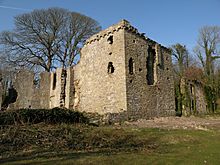Candleston Castle facts for kids
Quick facts for kids Candleston Castle |
|
|---|---|
| Merthyr Mawr, Wales | |

Candleston Castle, view from south of the 14th-century tower, to rear. Left the hall and domestic range, from the middle of which projects to left the 17th-century west wing. To right of the tower is the stable block, c. 1800.
|
|
| Coordinates | 51°28′57″N 3°37′38″W / 51.4825°N 3.6273°W |
| Site history | |
| Materials | Stone |
Candleston Castle is an old building from the 1300s. It was a fortified manor house, which means it was a large house built to be strong like a castle. Today, it is mostly in ruins.
The castle is located in Merthyr Mawr, in Bridgend county borough, Wales. It's about 1.2 kilometers (0.75 miles) southwest of Merthyr Mawr village. It's also very close to Ogmore Castle, with the River Ogmore flowing between them.
Candleston Castle was built on a low, narrow piece of land. This spot was good for defense. People believe the castle got its name from the Norman family of Cantilupe. They were likely the first important tenants of the land.
Contents
Where is Candleston Castle?
The ruins of Candleston Castle are found on the Merthyr Mawr Sand Dunes. This area is part of the Merthyr Mawr Warren. It's east of Porthcawl, near Swansea Bay. The castle was once part of a larger medieval village.
History of Candleston Castle
Early Years: 12th to 14th Centuries
In the 1100s, the land where Candleston Castle stands became part of the St Quintin family's lands. The Cantilupe family is thought to be the first to live there. Even though there are no exact records, the castle's name likely comes from them. Their name was spelled in different ways, like Cantulupo or Cantelo. Later, in 1596, it was called Cantelowstowne. In Welsh, it was known as Tregantlow.
Candleston Castle, a strong manor house, was built in the 1300s. A D-shaped wall surrounded the building. It's possible that this late-medieval manor was built on an even older site. This is because parts of an earlier wall have been found.
Robert de Canteilupe III might have built the castle. Records from 1320 show he owned land at Candleston. After Robert III, John de Cantilupe may have taken over. John might have been the Abbot of Margam in 1315. Robert de Cantilupe III's daughter, Joan, later inherited Candleston. She married Sir William Horton. He was from Tregwynt in Pembrokeshire.
Starting in the late 1300s, sand from the dunes began to move. It covered nearby Kenfig Castle, forcing people to leave. Candleston Castle was lucky. Its higher position saved it from the moving sand dunes. The sand surrounded the land but stopped close to the castle's southern wall.
Later Years: 15th to 19th Centuries
Candleston Castle passed through Joan Cantilupe Horton's family. It went to her son, Jenkin, and then to his daughter, Jennet (or Janet). The manor then became part of the Cradock family. This happened when Janet married Richard Cradock around 1468.
Another family, the Eyres, also held land at Candleston for a time. But Janet Horton and Richard Cradock eventually received the property.
Janet and Richard Cradock's son, Sir Mathew Cradock, inherited the castle. He lived from about 1468 to 1531. Sir Mathew was an important person. He managed lands and castles for the king. In the late 1400s, the manor was updated and changed. Mathew Cradock is believed to have done this work.
His only child, Margaret, inherited the manor. She married Sir Richard Herbert. Around 1500, more changes were made to the main hall. They added special arches and a large fireplace.
After Margaret and Sir Richard Herbert, George Herbert of Swansea inherited Candleston. Then his son, Mathew Herbert, held it. Later, two of Sir George Herbert's grandsons owned the manor. First, Sir William Herbert in 1598. Then his brother, Sir John Herbert, in 1609.
Sir John died in 1617. His daughter, Mary, inherited the property. She married Sir William Doddington.
The castle then passed to the Greville family. They were important nobles who visited only sometimes. They made small changes to the castle. In the 1700s, they sold it to the Franklen family.
Between 1806 and 1808, Sir John Nicholl lived at the manor. He bought Candleston Castle from Richard Franklen in 1830. At that time, it had several rooms, including bedrooms and a coach house. In the 1800s, it was used as a farm house. But later in the 1800s, people moved out, and it became a ruin.
In the early 1800s, some changes were made. A stable was built. The castle was also given crenellations to make it look more like a traditional castle. A defensive tower was also added. Near the castle, a stone base of a Calvary cross was found in 1823.
Candleston Castle Today: 20th and 21st Centuries
Today, Candleston Castle is an "ivy covered ruin." It's a peaceful place. You can see wild birds, butterflies, and different types of flowers there. The area around the castle has woodlands and farm land.
The nearby Merthyr Mawr dunes are very large. They are some of the biggest sand dunes in northwestern Europe. They are also the second-highest moving sand dune system in Europe. The dunes west of the castle are over 80 meters (260 feet) high. They are now quite stable and don't move as much.
Images for kids
See also
 In Spanish: Castillo de Candleston para niños
In Spanish: Castillo de Candleston para niños



